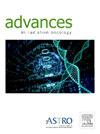The Use of Breast Cup Immobilization in Radiation Therapy and Patient-Reported Outcomes on Cosmesis and Pain
IF 2.7
Q3 ONCOLOGY
引用次数: 0
Abstract
Purpose
Breast cosmesis and breast pain are among the most reported outcomes in patients undergoing adjuvant breast irradiation. The degree to which such adverse reactions occur can be variable based on different patient-specific characteristics. It has been found that women with a larger body habitus, and larger breasts, tend to have an increased chance of experiencing worse toxicity from treatment. As such, attempts to improve cosmetic and pain outcomes have been a highly explored topic. One such technique, that is studied here, is to explore whether the use of a breast cup during treatment leads to worse breast pain and cosmetic outcomes when compared with those treated without a breast cup. This proves to be an important topic because it is believed that the use of a breast cup would provide a significant dosimetric advantage (ie, breast coverage and organ at risk dosing) during treatment. We now explore this treatment option through the scope of a retrospective analysis of patient-reported outcomes experienced during and after completing postoperative radiation therapy to the breast.
Methods and Materials
A total of 645 patients undergoing adjuvant breast irradiation were evaluated from 2011 to 2019. Of the 645 patients, 79 were treated using a breast cup. The mean heart dose was analyzed and compared between the 2 treatment groups. Additionally, patient-reported outcomes among the entire cohort were collected via survey documentation forms during treatment, at 1 month after the completion of treatment, and at 1 year after the completion of treatment. These results were collected using the Michigan Radiation Oncology Quality Consortium database because each patient was consented to enroll in the Michigan Radiation Oncology Quality Consortium prior to starting treatment. The outcomes of skin changes, lymphedema, and breast pain among the 2 treatment groups were then compared for statistically significant differences via a logistic regression analysis.
Results
Of the 79 patients treated with a breast cup, grade 2 pruritus of the treated breast along with grade 1 alteration in skin texture was reported in 49.4%, 35.4%, and 22.8% while on treatment, at 1 month after the completion of treatment, and at 1 year after treatment, respectively; P-values were nonsignificant at all timepoints when data compared with non-cup-treated patients. With regard to lymphedema, 59.5%, 40.5%, and 10.1% of breast cup patients at the prespecified timepoints reported this sequela; all P-values were nonsignificant except for the 1-month mark (P-value .03). Lastly, breast pain was noted in 36.7%, 15.2%, and 11.4% of breast cup-treated patients while on treatment, at 1 month after the completion of treatment, and at 1 year after treatment, respectively; again, P-values for data analysis at each timepoint were nonsignificant. Other than the patient-reported outcome of lymphedema 1 month after the completion of treatment, no statistical significance was seen in comparing side effects between the 2 treatment arms.
Conclusions
From our patients’ perspective, the use of a breast cup during radiation therapy did not negatively impact breast cosmesis or pain when compared with patients treated without a cup. Furthermore, breast cup use was also found to produce a lower overall mean heart dose in patients with left-sided breast cancer.
乳房罩杯固定在放射治疗中的应用及患者报告的美容和疼痛效果
目的乳房美容和乳房疼痛是报道最多的辅助乳房照射患者的结果。这些不良反应发生的程度可以根据不同患者的特点而变化。研究发现,体型更大、乳房更大的女性,在治疗过程中出现更严重毒性的可能性更大。因此,试图改善美容和疼痛的结果一直是一个高度探索的话题。这里研究的其中一项技术,是探索在治疗过程中使用乳房罩杯是否会比不使用乳房罩杯的治疗过程中导致更严重的乳房疼痛和美容效果。这被证明是一个重要的话题,因为人们相信在治疗期间使用乳房罩杯将提供显著的剂量学优势(即乳房覆盖和有风险的器官剂量)。我们现在通过回顾性分析患者在完成乳房术后放射治疗期间和之后报告的结果来探索这种治疗选择。方法与材料对2011 - 2019年接受乳腺辅助照射的645例患者进行评价。在645名患者中,79名患者使用了乳房罩杯。分析比较两治疗组的平均心脏剂量。此外,在治疗期间、治疗完成后1个月和治疗完成后1年,通过调查文件表格收集了整个队列中患者报告的结果。这些结果是通过密歇根放射肿瘤学质量联盟数据库收集的,因为每位患者在开始治疗前都同意加入密歇根放射肿瘤学质量联盟。通过logistic回归分析比较两组患者在皮肤变化、淋巴水肿和乳房疼痛方面的差异。结果79例使用乳杯治疗的患者中,治疗期间、治疗结束后1个月和治疗后1年分别有49.4%、35.4%和22.8%的患者报告乳房出现2级瘙痒并伴有1级皮肤质地改变;与未接受杯子治疗的患者相比,p值在所有时间点均不显著。至于淋巴水肿,59.5%、40.5%和10.1%的罩杯患者在预先指定的时间点报告了这种后遗症;除第1个月外,所有p值均不显著(p值为0.03)。最后,36.7%、15.2%和11.4%的乳房杯治疗患者在治疗期间、治疗完成后1个月和治疗后1年分别出现乳房疼痛;同样,每个时间点数据分析的p值均不显著。除了患者报告的治疗完成1个月后淋巴水肿的结局外,两个治疗组的副作用比较无统计学意义。结论:从患者的角度来看,与不使用乳房罩杯的患者相比,在放射治疗期间使用乳房罩杯对乳房美容或疼痛没有负面影响。此外,研究还发现,在左侧乳腺癌患者中,使用乳房罩杯会产生较低的总体平均心脏剂量。
本文章由计算机程序翻译,如有差异,请以英文原文为准。
求助全文
约1分钟内获得全文
求助全文
来源期刊

Advances in Radiation Oncology
Medicine-Radiology, Nuclear Medicine and Imaging
CiteScore
4.60
自引率
4.30%
发文量
208
审稿时长
98 days
期刊介绍:
The purpose of Advances is to provide information for clinicians who use radiation therapy by publishing: Clinical trial reports and reanalyses. Basic science original reports. Manuscripts examining health services research, comparative and cost effectiveness research, and systematic reviews. Case reports documenting unusual problems and solutions. High quality multi and single institutional series, as well as other novel retrospective hypothesis generating series. Timely critical reviews on important topics in radiation oncology, such as side effects. Articles reporting the natural history of disease and patterns of failure, particularly as they relate to treatment volume delineation. Articles on safety and quality in radiation therapy. Essays on clinical experience. Articles on practice transformation in radiation oncology, in particular: Aspects of health policy that may impact the future practice of radiation oncology. How information technology, such as data analytics and systems innovations, will change radiation oncology practice. Articles on imaging as they relate to radiation therapy treatment.
 求助内容:
求助内容: 应助结果提醒方式:
应助结果提醒方式:


